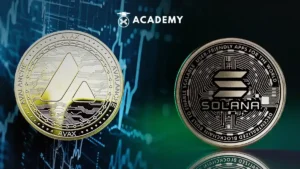Avalanche and Solana both prioritize speed and efficiency, but each has taken a different technological path.
So, which one is more suitable for your profits in 2025? Well, to find out, let’s read the full review below!
Vision & Philosophy: Modularity vs. Monolithic Speed

While both designed to address scalability and transaction efficiency, Avalanche and Solana take very different architectural approaches.
Avalanche has chosen a modular path with a three-chain structure: the X-Chain for asset transfers, the EVM-compatible C-Chain for smart contracts, and the P-Chain for validator management.
With Snowman consensus and the concept of subnets, Avalanche enables the creation of specialized blockchains that can be customized to user needs.
This approach makes it easier for developers to migrate dApps from Ethereum and create a more flexible ecosystem.
Meanwhile, Solana takes a monolithic approach focused on extreme speed.
Solana combines Proof of Stake with Proof of History to automatically record the sequence of transactions without relying on global time synchronization.
Transactions are processed by thousands of validators using GPUs, achieving high throughput at very low costs.
The philosophy is to build a single, unified, super-fast blockchain without the need for splitting into multiple chains.
These differences in approach reflect two key philosophies in the blockchain world: Avalanche prioritizes decentralization with a modular architecture, while Solana focuses on efficiency through an integrated system.
Core Technology: Avalanche Consensus vs. PoH + PoS
The core technological difference between Avalanche and Solana lies in their approach to achieving network speed, security, and scalability.
Avalanche relies on Snowman consensus, which operates on a three-chain architecture:
- X-Chain for asset transfers,
- C-Chain for EVM-based smart contracts, and
- P-Chain for validator management and staking.
These three chains exist within a single ecosystem that can be expanded through the concept of subnets, which are specialized blockchains with their own rules that still receive security from Avalanche validators.
This makes Avalanche a highly modular and flexible platform, perfect for developers looking to build their own ecosystems or migrate applications from Ethereum.
In terms of performance, Avalanche is capable of handling over 4,500 transactions per second, with an average finality of less than one second.
Solana, on the other hand, takes a different approach by building a single, super-fast blockchain.
Solana combines Proof of Stake and Proof of History, an innovative method that records transaction times on-chain to create a verifiable sequence.
With the help of thousands of GPU-based validators, Solana can process up to 65,000 transactions per second under optimal conditions.
Solana does not natively support the EVM, but compatibility is being developed through projects like Neon Labs. The primary language for smart contracts on Solana is Rust, which is designed for high performance.
Speed & TPS: Who’s Faster?
In terms of raw speed, Solana stands out as one of the fastest blockchains today. With a combination of Proof of Stake and Proof of History consensus, the network has achieved up to 65,000 transactions per second (TPS) in testing.
In fact, there are theoretical projections that Solana could reach 600,000 TPS in the future, although this has not been tested in real life. This makes Solana ideal for applications that require high throughput, such as DeFi, gaming, and NFT trading.
Avalanche, meanwhile, offers a different approach. The main chain is capable of processing around 4,500 TPS, with an average transaction finalization time of just 0.79 seconds.
However, Avalanche’s advantage lies in its ability to run multiple subnets in parallel.
Each subnet can be configured for specific needs and has its own blockchain, meaning network performance can be adjusted and improved without burdening the main chain.
Essentially, Solana excels in raw speed within a single chain, while Avalanche excels in flexibility and parallelism across subnets.
Solana is well-suited for high traffic within a centralized ecosystem, while Avalanche provides developers with more room to build independent yet interconnected blockchain networks.
Transaction Fees & Efficiency

Solana is known for its extremely low transaction fees, averaging only around $0.00025 per transaction.
With an architectural design that relies on Proof of Stake and Proof of History, this network is capable of executing transactions quickly and cheaply, making it ideal for DeFi applications, NFTs, and high-frequency on-chain activity.
On the other hand, Avalanche also offers low fees, especially when utilizing custom subnets. Because subnets can be tailored to specific needs, developers can adjust network parameters, including the fee structure.
This gives Avalanche great flexibility in managing transaction efficiency, especially for large-scale or complex applications.
In terms of consistency, Solana excels in offering super-low on-chain fees, but the network also has a history of frequent outages.
Avalanche is more stable in operation, although transaction fees can vary slightly depending on the chain or subnet used.
So, if you need ultra-low fees for intensive transactions, Solana has the edge on the raw cost side.
However, if you’re looking for a balance between efficiency and long-term stability, especially in a customizable network architecture, then Avalanche is a worthy choice.
Ecosystem: dApps, DeFi, GameFi, & Subnets
Solana has become home to many popular retail and DeFi applications. The platform excels in user transaction volume thanks to its extremely low fees and high transaction speeds. Some of the biggest names in its ecosystem include:
- Jupiter – the largest DEX aggregator on Solana
- MarginFi and Kamino – providers of automated lending and yield strategies
- Star Atlas – an ambitious GameFi project with AAA graphics
- BONK – a community-driven memecoin that is strengthening retail appeal
With a TVL of $6,700,000,000, Solana far outperforms Avalanche in terms of total value locked in DeFi. Its NFT and GameFi ecosystems are also growing rapidly, making it a hub of on-chain activity for end-users (retail).
Meanwhile, Avalanche is taking a different path by emphasizing a multichain and subnet architecture.
Avalanche enables the creation of specialized blockchain networks (subnets) that can be customized for enterprise needs or large applications.
GameFi projects like Shrapnel are built on Avalanche subnets, which enable high performance without burdening the main chain. Some key DeFi projects on Avalanche include:
- Trader Joe – Avalanche’s flagship DEX
- Pangolin – an EVM-compatible DEX
- Benqi and GMX – decentralized lending and derivatives
With a TVL of around $1,400,000,000, Avalanche lags behind in terms of DeFi volume, but excels in infrastructure flexibility and institutional adoption.
This makes it an attractive option for developers and enterprises looking to build custom blockchain solutions.
Solana is primarily dominant in the retail sector, DeFi volume, and a vibrant on-chain ecosystem.
Avalanche, on the other hand, excels in modularity and multichain capabilities, particularly with subnets suitable for GameFi and enterprise-grade blockchains.
The choice depends on whether you’re more interested in mass adoption or long-term technical flexibility.
Security & Decentralization
Both Solana and Avalanche use the Proof-of-Stake mechanism, which allows for open participation as validators. However, their approaches to decentralization and security differ.
Solana has approximately 1,850 validators, making it one of the most actively participatory networks.
However, its hardware requirements are quite high, and validators must incur operational costs in SOL daily just to submit transaction votes.
This can limit participation from smaller entities, potentially impacting the network’s decentralization in the long term.
Furthermore, Solana is notorious for its history of downtime, including the most recent major incident in February 2024, when the network was down for nearly five hours. In total, Solana has experienced more than 10 major outages since 2020.
Avalanche, on the other hand, relies on 1,200 active validators, with a staking requirement of 2,000 AVAX to join as a full validator.
This creates a robust layer of economic-based security, especially since all subnets must also participate in validating the main network.
Significantly, subnets on Avalanche allow entities to create custom blockchains with their own validation rules, while remaining tied to the core network’s security through AVAX staking.
Since its launch, Avalanche has been relatively stable, experiencing only one major downtime in March 2023.
Overall, Solana has a strong validator count, but is often hampered by network reliability.
Meanwhile, Avalanche offers architectural flexibility through subnets, with a staking-based security approach and more consistent uptime to date.
Market Cap & Popularity
In terms of market capitalization as of July 30, 2025, according to Coinmarketcap, Solana far outperforms Avalanche. Solana recorded a market cap of $96,925,000,000, placing it in the top five in the global crypto ecosystem, just behind Ethereum.
This dominance demonstrates the level of investor interest in Solana’s performance as a high-speed platform for decentralized applications, DeFi, and NFTs.
Meanwhile, Avalanche recorded a market cap of around $10,216,000,000, keeping it in the top 20.
Although quite a distance behind, this position still reflects market confidence in Avalanche’s potential, particularly with its subnet approach and EVM compatibility, which attract dApp developers from the Ethereum ecosystem.
Solana also tends to be more active in terms of liquidity and daily trading volume. The number of DEXs, DeFi protocols, and NFT activity on the Solana network significantly contributes to the more dynamic circulation of SOL tokens.
Avalanche may lag behind in terms of numbers, but it offers a more modular and flexible ecosystem for institutions or projects with high-customization needs.
Judging from its current market position, Solana has the edge as a mature Layer 1 network in terms of adoption. On the other hand, Avalanche is still building momentum, particularly through subnet expansion and enterprise collaboration.
Which One is Right for You?
The choice between Solana and Avalanche largely depends on your goals and needs in the crypto world. If you’re a developer or development team looking to build a custom blockchain, Avalanche may be a better fit.
This platform offers a Subnet feature that allows you to create a blockchain network with your own rules and design, while still enjoying the security of Avalanche’s validators.
Furthermore, Avalanche is compatible with the Ethereum Virtual Machine (EVM), making it easy to use for developers already familiar with building in the Ethereum ecosystem.
Conversely, if you’re more focused on being a trader, DeFi user, or NFT collector, Solana may be a more practical choice.
Solana’s advantages lie in its very low transaction fees and high speed, processing thousands of transactions per second.
This makes Solana ideal for daily activities like trading, yield farming, and even buying and selling NFTs without having to worry about expensive gas fees like on Ethereum.
So, simply put, if you need more control, want to build complex blockchain solutions, or bring dApps from Ethereum, then Avalanche is the right choice.
However, if you want fast and affordable access to DeFi, NFTs, or ready-to-use dApps, then Solana could be the best solution. Ultimately, you can choose what best aligns with your orientation and strategy for navigating the Web3 world.
Conclusion: Equally Fast, Different Paths
So, that was an interesting discussion about AVAX vs. Solana 2025: Modular Avalanche vs. Superfast Solana, which you can read in full at the INDODAX Academy.
In conclusion, there’s no need to choose one over the other in the crypto academy. Both play a crucial role in the ever-evolving Web3 landscape.
On the one hand, Avalanche offers high flexibility for developers looking to build modular blockchain solutions.
On the other hand, Solana offers incredible speed and cost efficiency for users looking to jump right into the world of DeFi, NFTs, or other Web3 applications.
With their different, yet equally robust, approaches, the two can actually complement each other, creating a richer and more diverse ecosystem. So, there’s no harm in exploring both, depending on your strategy and vision for your future profits.
So, are you ready to start your journey in the world of Layer 1 crypto? You can buy AVAX and SOL now on the Indodax Market. The process is fast, secure, and you can use it directly in Rupiah.
By the way, besides broadening your investment horizons, you can also stay updated with the latest crypto news and monitor digital asset price movements directly on the INDODAX Market. For a more personalized trading experience, explore our OTC trading service on INDODAX.
Don’t forget to activate notifications to stay up-to-date with the latest information about digital assets, blockchain technology, and various other trading opportunities only on INDODAX Academy.
You can also follow our latest news through Google News for faster and more reliable access to information. For an easy and secure trading experience, download INDODAX’s best crypto app on the App Store or Google Play Store.
Maximize your crypto assets with the INDODAX Earn feature, a practical way to earn passive income from your holdings.

Also follow our social media here: Instagram, X, Youtube & Telegram
FAQ
1.What’s the difference between Avalanche and Solana?
Solana focuses on a single, super-fast chain, while Avalanche builds a modular network across multiple subnets.
2.Which is faster for transactions?
Solana has the edge in raw TPS, but Avalanche can scale across multiple subnets in parallel.
3.Which is better suited for developers?
Avalanche is suitable for those who want to create their own blockchain (subnet). Solana is suitable for building on a single chain with large volumes.
4.Which token is more liquid and popular?
SOL is more popular and liquid in the retail market. AVAX has a strong market in the institutional and enterprise subnets.
5.Can you buy AVAX and SOL on Indodax?
Absolutely! You can buy both directly on the Indodax Market with Rupiah.
Author: Boy





 Polkadot 8.91%
Polkadot 8.91%
 BNB 0.54%
BNB 0.54%
 Solana 4.81%
Solana 4.81%
 Ethereum 2.37%
Ethereum 2.37%
 Cardano 1.35%
Cardano 1.35%
 Polygon Ecosystem Token 2.11%
Polygon Ecosystem Token 2.11%
 Tron 2.85%
Tron 2.85%
 Market
Market


